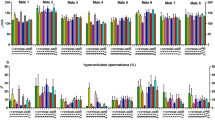Abstract
ALTHOUGH spermatozoa bear histocompatibility antigens (H-2 in mice1,2 and HL-A in man3,4) accelerated (immune) skin graft rejection is not known to occur in females previously multiply inseminated by a graft donor. The absence of detectable transplantation immunity in inseminated females correlates with the generally low immunogenicity of spermatozoa given by other routes. The decreased antigenicity of spermatozoa is not explained by a privileged immune status of the female reproductive tract as the vaginal route is adequate for immunisation against a variety of antigens5, especially if the tract is wounded6, and antibodies to spermatozoa decrease fertility in some situations7. Thus, it is probable that mechanisms have evolved to maintain a low immunogenicity of spermatozoa. What seems to be an exception to the low immunogenicity of spermatozoa—that antibody to a tissue-specific sperm antigen occurs naturally without deliberate immunisation8,9 and is readily elicited in a variety of species10—may represent a protective mechanism. Many substances present in seminal plasma may exert a suppressive effect by coating sperm membrane antigens or inducing immunosuppression by other means.
This is a preview of subscription content, access via your institution
Access options
Subscribe to this journal
Receive 51 print issues and online access
$199.00 per year
only $3.90 per issue
Buy this article
- Purchase on Springer Link
- Instant access to full article PDF
Prices may be subject to local taxes which are calculated during checkout
Similar content being viewed by others
References
Vojtiskova, M., Nature, 222, 1293–1294 (1964).
Erickson, R. P., in The Genetics of Spermatozoa, (edit. by Beatty, R. A., and Waelsch, S. G.), 191–202 (Edinburgh, 1972).
Fellous, M., and Dausset, J., Nature, 225, 191–193 (1970).
Kerek, G., and Afzelius, B. A., Int. J. Fert., 17, 120–126 (1972).
Edwards, R. G., J. Reprod. Fert., 1, 385–401 (1960).
Bratanov, K., in Immunology and Reproduction (edit. by Edwards, R. G.), 178–185 (International, New York, 1969).
Tyler, A., J. Reprod. Fert., 2, 473–506 (1961).
Johnson, M. H., J. Reprod. Fert., 16, 503–506 (1968).
Padma, M. D., Nature new Biol., 238, 25–26 (1972).
Bach, F. M., Transplant. Proc., 5, 23–30 (1973).
Boyum, A., Scand. J. clin. Lab. Invest. Suppl., 97, 1–109 (1968).
Taylor, P. L., and Kelly, R. W., Nature, 250, 665–667 (1974).
Webb, D. R., Stites, D. P., Perlman, J. D., Austin, K. E., and Fudenberg, H. H., Clin. Immunol. Immunopath., 2, 322–332 (1974).
Levis, W. R., Whalen, J. J., and Sherins, R. J., Lancet, ii, 954–955 (1974).
Singal, D. P., Berry, R., and Naipul, N., Nature new Biol., 233, 61–62 (1971).
Singal, D. R., Berry, R., Transplantation, 13, 441–442 (1972).
Forlani, L., Chiancone, E., Vecchini, P., Floridi, A., D'Alessio, G., and Leone, E., Biochim. biophys. Acta, 140, 170–173 (1967).
Huggins, C. B., and Neal, W., J. exp. Med., 76, 517–541 (1942).
Lang, C. J., Kummer, J. F., and Hartley, D. P., New Engl. J. Med., 291, 121–123 (1974).
Kearns, D. H., Siebert, G. B., O'Reilly, R., Lee, L., and Logan, L., New Engl. J. Med., 289, 1170–1174 (1973).
McLaren, A., Nature, 201, 582–585 (1964).
Edwards, R. G., Nature, 203, 50–53 (1964).
Bell, E. B., and McLaren, A., J. Reprod. Fert., 22, 345–356 (1970).
Author information
Authors and Affiliations
Rights and permissions
About this article
Cite this article
STITES, D., ERICKSON, R. Suppressive effect of seminal plasma on lymphocyte activation. Nature 253, 727–729 (1975). https://doi.org/10.1038/253727a0
Received:
Revised:
Published:
Issue Date:
DOI: https://doi.org/10.1038/253727a0
This article is cited by
-
Opioid peptides in the testis and the male genital tract: presence and possible function
Journal of Endocrinological Investigation (1986)
-
Effect of human seminal plasma on tumour-associated immunity in prostatic cancer. A preliminary report
Experientia (1979)
Comments
By submitting a comment you agree to abide by our Terms and Community Guidelines. If you find something abusive or that does not comply with our terms or guidelines please flag it as inappropriate.



